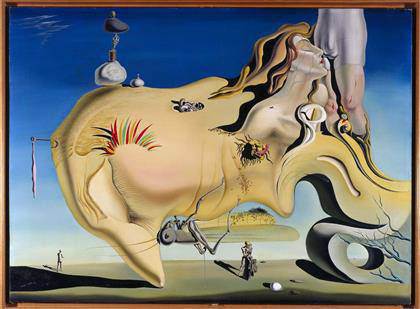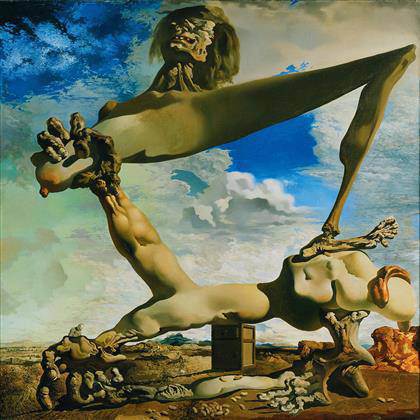
Salvador Dalí
Visage du Grand Masturbateur (The Great Masturbator)
1929
Oil on canvas, 110 x 150 cm.
© Salvador Dalí, Fundación Gala-Salvador Dalí, VEGAP Madrid 2013

Salvador Dalí
Soft Construction with Boiled Beans (Premonition of Civil War)
1936
Oil on canvas, 99.9 x 100 cm.
© Salvador Dalí, Fundación Gala-Salvador Dalí, VEGAP Madrid 2013
Salvador Dalí retrospective at Reina Sofía Madrid The Museo Reina Sofía presents a major exhibition dedicated to Salvador Dalí, one of the most comprehensive shows yet held on the artist from Ampurdán. April 27 – September 2, 2013.]]>
Source: Reina Sofía Museum, Madrid
Gathered together on this unique occasion are more than 200 works from leading institutions, private collections, and the three principal repositories of Salvador Dalí’s work, the Fundació Gala-Salvador Dalí (Figueres), the Salvador Dalí Museum of St. Petersburg (Florida), and the Museo Reina Sofía (Madrid), which in this way are joining forces to show the public the best of their collections.
The exhibition is made up of eleven sections containing not only paintings and drawings but also documentary material, photographs, Dalí’s own manuscripts, magazines and films of enormous importance for an understanding of the artist’s complex universe.
1. From the multiplying glass to putrefaction / 2. Self-portraits
The exhibition opens with a section devoted to Dalí’s earliest works. Predominant hereare the elements that marked his childhood, such as his family – “Portrait of my Father”(1925) or “Girl at the Window” (1925) – and his natural surroundings during those years, asin “Cliffs” (1926) and “Landscape of Cadaqués” (1923).
3. Honey is sweeter than blood
His arrival in late 1922 at the Residencia de Estudiantes in Madrid, where he met, amongothers, Federico García Lorca and Luis Buñuel (with whom he collaborated on the 1929film “Un chien andalou”), brought him face to face with the ‘Generation of ’27’, a groupformed by poets, writers, painters and film-makers.
4. Surrealism
It was during his surrealist period itself that Dalí developed his paranoiac-critical method, the focus of attention in the next section of the exhibition, with such great works as “The Great Masturbator” (1929), and “The Persistence of Memory “(1931).
5. The Angelus
The itinerary continues with a section dedicated to the artist’s re-reading of “The Angelus”(1857-59) by Jean-François Millet.
6. The face of war / 7. Surrealism after 1936
After 1936, Dalí and Gala fled from the Spanish Civil War, spending most of the time inFrance with the exception of occasional trips to the United States and Italy. The artisttransferred his personal experience to such disturbing oil paintings as “The Face of War” (1940).
8. America
The start of the Second World War forced Dalí and Gala into exile in the United States,where they lived uninterruptedly from 1940 to 1948. Works like “Raphaelesque HeadExploding” (1951) and “The Maximum Speed of Raphael’s Madonna” (1954) arerepresentative of this phase.
9. The secret life
Shown in this section are thirty original drawings used in the 1940s to illustrate hisautobiography, “The Secret Life of Salvador Dalí”, a magnificent piece of writing that isoften regarded by critics as his best.
10. Scenarios
Dalí defined himself as an eminently theatrical artist. From his cinematic incursions in collaborations with Luis Buñuel, Alfred Hitchcock andWalt Disney to his set designs for theatre and ballet, we see how the mastery andingenuity of Dalí the painter placed itself at the service of the entertainment industry, afield that lay outside his own.
11. The aesthetic enigma
From the 1960s to the end of his career, Dalí’s interests continued to expand. In the 1980s, the mathematical theories of RenéThom gave form to a new universe which the painter was thereafter never to abandon, anexample being his last work, “Swallow’s Tail and Cellos” (1983).
Related content
Exhibition of Salvador Dali’s late work at High Museum of Art (exhibition, 2010 – 2011)
Follow us on:


